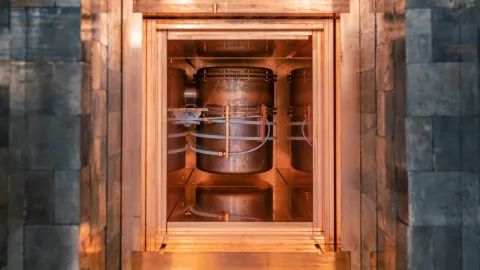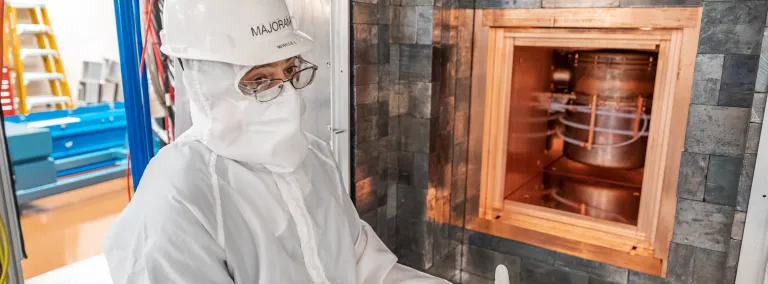The neutrino puzzle
Researchers continue to piece together information about the ghostly particle
Imagine trying to put together a jigsaw puzzle that has no picture for reference, is missing several pieces and, of the pieces you do have, some don’t quite fit together.
Welcome to the life of a neutrino researcher.
Vincente Guiseppe began his neutrino journey 15 years ago as a post-doc at Los Alamos National Laboratory. He worked with germanium detectors and studied radon while a graduate student and followed the scientific community’s progress as the Solar Neutrino Problem was solved. The so-called Solar Neutrino Problem was created when Dr. Ray Davis Jr., who operated a solar neutrino experiment on the 4850 Level of the Homestake Gold Mine, discovered only one-third of the neutrinos that had been theorized. Nearly 30 years after Davis began his search, the problem was solved with the discovery of neutrino oscillation.
“I began to understand that neutrinos had much more in store for us. That led me to move to neutrino physics and set me up to transition to the Majorana Demonstrator (Majorana) project,” said Guiseppe, who is now a co-spokesperson for Majorana, located nearly a mile underground at SURF, and a senior research staff member at Oak Ridge National Lab (ORNL).

Majorana uses germanium crystals in a search for the theorized Majorana particle—a neutrino that is believed to be its own antiparticle. Its discovery could help unravel mysteries about the origins of the universe and would add yet another piece to this baffling neutrino puzzle.
We caught up with Guiseppe recently to talk about neutrinos—what scientists know (and don’t know), why neutrinos behave so strangely and why scientists keep searching for this ghost-like particle.
SURF: What are neutrinos?
Guiseppe: Let’s start with what we know. Of all the known fundamental particles that have mass, neutrinos are the most abundant—only the massless photon, which we see as light, is more abundant. We know their mass is quite small, but not zero—much lighter than their counterparts in the Standard Model of Physics—and we know there are three types and that they can change flavors. They also rarely interact with matter, which makes them difficult to study.
All of these data points are pieces of that neutrino puzzle. But every piece is important if we want to complete the picture.
SURF: Why should we care about the neutrino?
Guiseppe: We care because they are so abundant. It's almost embarrassing to have something that is so prevalent all around us and to not fully understand it. Think of it this way: You see a forest and the most abundant thing in that forest is a tree. But that's all you know. You don't know anything about how a tree operates. You don't know how it grows, you don't know why it's green, you don't know why it’s alive. It would be embarrassing to not know that. But that's not the case with trees. Something so abundant as what we see in nature—animal species, trees, plants—we understand them completely, there's nothing surprising. So, the fact that they are so abundant, and yet we know so little about them, brings a sort of duty to understand them.
SURF: What intrigues you most about neutrino research?
Guiseppe: Most? I would say the breadth of research and the big questions that can be answered by a single particle. While similar claims could be made about other particle research, the experimental approach is wide open. We look for neutrinos from nuclear reactors, particle accelerators, the earth, our atmosphere, the sun, from supernovae, and some experiments are only satisfied if we find no neutrinos, as in the case of neutrinoless double-beta decay searches. Neutrino research places detectors in underground caverns, at the South Pole, in the ocean, and even in a van for drive-by neutrino monitoring for nuclear safeguard applications. It's a diverse field with big and unique questions.
SURF: What is oscillation?
Guiseppe: Oscillation is the idea that neutrinos can co-exist in a mixture of types or “flavors.” While they must start out as a particular flavor upon formation, they can evolve into a mixture of other flavors while traveling before falling into one flavor upon interaction with matter or detection. Hence, they are observed to oscillate between flavors from formation to detection.
SURF: It’s a fundamental idea that a thing can’t become another thing unless acted upon by an outside force or material. How can something spontaneously become something it wasn’t a split second ago? And why are we OK with that?
Guiseppe: Are people really okay with the idea of neutrinos changing flavors? I think we are, inasmuch as we are really okay with the implications of quantum mechanics? (As an aside, this reminds me of a question I asked my undergraduate quantum mechanics professor. I felt I was doing fine in the class and could work the problems but was worried that I really didn’t understand quantum mechanics. He responded with a slight grin: “Oh, no one really ‘understands’ quantum mechanics.”).
It is quantum mechanics at work that makes this flavor change possible. Since neutrinos come in three separate flavors and three separate masses (and more importantly, each flavor does not come as a definite mass), they can exist in a quantum mechanical mixture of flavors. The root of your concern stems from the idea of its identify—what does it mean to change this identity?
The comforting aspect is that neutrinos are not found to change speed, direction, mass, shape, or anything else that would require an outside force or energy in the usual sense. By changing flavor, the neutrino is only changing its personality and the rules by which it should follow at a given time.
While this bit of personification is probably not comforting, it is only how the neutrino must interact with other particles that changes over time. You could think of the neutrino as being formed as one type, but then realizing it is not forced into that identity. It then remains in an indecisive state while being swayed to one type over another before finally making a decision upon detection or other interaction. In that sense, it is not a spontaneous change, but the result of a well thought-out (or predictable) decision process.
SURF: What is a Majorana Particle and why is it important?
Guiseppe: A Majorana particle is one that is indistinguishable from its antimatter partner. This sets it apart from all other particles. With the Majorana Demonstrator, we are looking for this particle in a process called neutrinoless double-beta decay.
Neutrinoless double-beta decay is a nuclear process whereby two neutrons transform into two protons and electrons (aka, beta particles), but without the emission of two anti-neutrinos. This is in contrast to the two neutrino double-beta decay process where the two anti-neutrinos are emitted; a process that has been observed.
SURF: Why neutrinoless double-beta decay?
Guiseppe: Neutrinoless double-beta decay experiments offer the right mix of simplicity, experimental challenges, and the potential for a fascinating discovery. The signature for neutrinoless double-beta decay is simple: a measurement made at a specific energy and at a fixed point in the detector. But it’s a rare occurrence that is easily obscured so reducing all background (interferences) that can partially mimic this signature and foil the measurement is critical. Searching for this decay requires innovative detectors, as well as the ability to control the ubiquitous radiation found in everything around us.

SURF: After so many years, how do you stay enthusiastic about neutrino research?
Guiseppe: Its book isn’t finished yet. We have more to learn and more questions to answer—we only need the means to do so. I stay enthused due to the likelihood of some new surprises (or comforting discoveries) that await. Along the way, we can continue to make advances in detector technology and develop new (or cleaner) materials, which inevitably lead to applications outside of physics research. In the end, chasing down neutrino properties and the secrets they may hold remains exciting due to clever ideas that keep the next discovery within reach.
